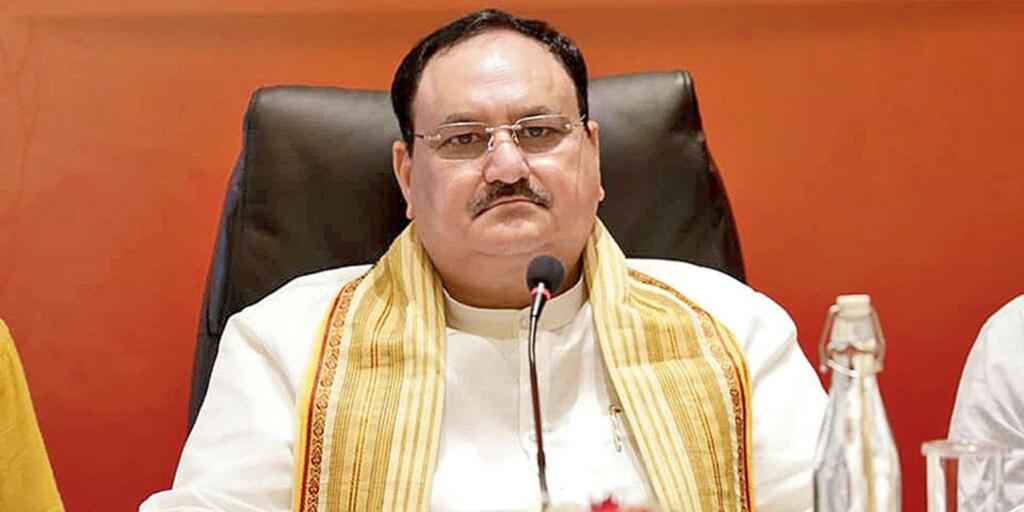BJP President JP Nadda: Ideology, Leader and cadre (karyakartas) are the three strong pillars on which any party’s structure rests. Since the time of Jan Sangh, BJP and its successor have been steadfast on the ideological front. It has Nationalism, Vikas (Development), Integral Humanism/Antyodaya and positive secularism at the core of its ideology. On the Karyakarta front, BJP has become the largest political party in the world.
However, the saffron party has been caught wanting for leaders in many states. It had to suffer defeats because of its state level politicians putting efforts in different directions. That is what makes the role of its Central leadership particularly its President more important. It becomes his duty to reap benefits equivalent to the enormous capabilities of its resources be it ideology, cadre or effective policies. But the tenure of BJP President JP Nadda so far indicates that he doesn’t seem to be up to the mark.
Chronicles of JP Nadda as BJP’s President
Hailing from Himachal Pradesh, JP Nadda was appointed working president of BJP in June 2019. His elevation came on the backdrop of his extensive work as Union Health Minister in the first tenure of the Modi government and impressive track record in Himachal politics. From June 2019 to January 2020, he remained the acting Party President until he was officially shouldered the responsibility as the full-time President of BJP on 20th of January 2020.
After that, the electoral juggernaut BJP has a mixed track record in terms of electoral success. He has failed to put an end to divisions within several state units. He also failed to launch attacks against the opposition ruled states governments.
Also read: “JP Nadda, Go Back”: Nitish Kumar’s hate for the BJP is now out in the open
The shortfalls
JP Nadda took the party baton from Amit Shah under whose leadership BJP was seen as an invincible party. However, under JP Nadda’s leadership, BJP has suffered a massive erosion in this imagery and has been regularly falling short in achieving its desired targets.
In his Presidency, BJP failed badly in the assembly elections held in Delhi, Jharkhand, West Bengal, Haryana and Bihar. In Maharashtra too, BJP President JP Nadda failed to tackle and quell the rebellion of the party’s alliance partner, Shiv Sena.
Further, the party suffered defeats in electorally significant by-polls in Haryana and other states all throughout his tenure as the Party President.
The major factor of many of these defeats has been rebellion and constant in-fight within the saffron party. Evidently, Bihar BJP has become a disorganised, dysfunctional and a leaderless unit with no aim and direction for the future. Quite Ironically, he once made a controversial statement and de-linked BJP (the saffron party) with Bhagwa.
Also read: BJP’s silence in West Bengal proves costly as party president JP Nadda’s convoy gets attacked
The biggest taint
The biggest setback for BJP in JP Nadda’s Presidency is the loss in his home turf Himachal Pradesh. He was extensively involved in the candidate selection process and selecting agendas for the election campaigning. There were several oppositions to his style of functioning, especially the ticket distribution.
Notably, this also played a crucial role in the party’s defeat in the hilly state. Many karyakartas who had a strong say and command on ground were forced to go on the rebellious path and contest independently. Resultantly, he couldn’t deliver victory for the party in his home state Himachal marking a great blot on his Presidential tenure.
The similar chaotic scenes are visible in Delhi BJP. The internal party politics and ill-thought ticket distribution brought a defeat for the party in its own citadel, MCD.
Couldn’t match the legacy of his predecessor
In JP Nadda’s Presidency, BJP seems to have adopted the policy of cautious defence rather than ruthless and aggressive politics practised by the earlier party Presidents.
Evidently, in contrast to JP Nadda, his predecessors like Kushabhau Thakre, Rajnath Singh or Amit Shah expanded the party’s presence and the party grew manifold.
During Amit Shah’s Presidency, he and PM Narendra Modi were considered an unbeatable duo. At that time, BJP became the largest political party in the world. Defeating BJP became next to an impossible task.
But things have changed under the new President JP Nadda. Rather than taking the party forward, the saffron party has been struggling to hold on to its political gains. Rather than expanding aggressively in new frontiers, under his leadership, the party’s growth has stagnated.
JP Nadda’s first tenure as President of BJP is about to end in January 2023. There were credible reports that his tenure was extended till Lok Sabha elections 2024. However, under his leadership the party has not been able to repeat the massive success of its past party President. Past few electoral losses have caused a major setback for the party. BJP has a track record of major reshuffles and organisational changes post electoral defeats to cater the feedback of voters.
Therefore, there is a possibility that his re-election may not be that smooth this time or he may have to go through internal party elections and adopt a more aggressive election strategy going ahead.
Support TFI:
Support us to strengthen the ‘Right’ ideology of cultural nationalism by purchasing the best quality garments from TFI-STORE.COM
